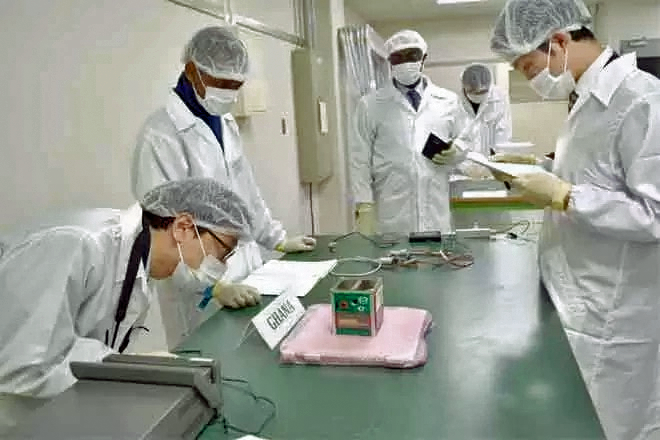
JAXA safety team inspecting the flight model of GhanaSat-1. Looking on is Dr Donkor.
After a successful launch of Ghana’s first satellite, GhanaSat-1, on June 1, 2017, in Florida, the country’s first space technology is set to be deployed into orbit on July 6 or 7.
GhanaSat 1 will be deployed from the International Space Station (ISS) into orbit at an estimated altitude of 400 kilometers above the Earth's atmosphere via the Japan/Kibo Deployment System on board the ISS. On satellite deployment day, the management of All Nations University College (ANUC), led by Dr. Samuel Donkor, will join Ghana’s Ambassador to Japan, Mr. Parker Allotey, at the Japan Aerospace Exploration Agency (JAXA) Tsukuba Space Centre to participate in the event. The duo will join others in monitoring the countdown to the deployment of the satellites from the ISS, interviews and a press conference.
As part of the event, the nation's President, Nana Addo Dankwa Akufo-Addo, is expected to send a congratulatory message via video conference to the Ghana team who built the satellite.
GhanaSat—1 Operation
The satellite will be controlled from the ground using the All Nations ‘s amateur ground station located on the university’s main campus in Koforidua. The ground station will establish communication with GhanaSat-1 using UHF/VHF amateur frequency bands. It will also be supported by Birds Ground Station Network, which is managed by Infostellar Company and all Ham radio operators across the world.
The ANUC ground station will be used to track the satellite passing over Ghana, receive health telemetry data status of the satellite and send command to satellite during its passing over. While traversing the country’s space, the satellite will accomplish several missions, including taking pictures of the country to monitor the coastal regions and to demo space to ground communication by broadcasting songs from space to stimulate Science, Technology, Engineering and Mathematics (STEM) education in Ghana. The smallsat will also measure the effects of radiation on satellite components, especially its microprocessors, to contribute to space science research (popularly known as Single Event Latch (SEL) up mission).
The GhanaSat-1 mission data will be made available to the government and non-governmental institutions to build capacity in space science and technology applications.
JAXA took delivery of the cubesat, dubbed Ghanasat-1, on February 9, 2017, and handed it over to the National Aeronautics and Space Administration (NASA) in Florida on February 13. The successful launch of the cubesat, which weighs 1,000 grams, is expected to make the dream of Ghana becoming a space-faring nation a reality and also boost the country’s capacity to take advantage of space science and technology in the future. Images of the event will be beamed live at the ANUC campus in Koforidua.
This smallsat, described as the first university satellite in sub-Saharan Africa, has low and high resolution cameras on board to take pictures of our homeland and provide data that can be used to monitor the coastal areas of Ghana. It also has a Digi-Singer SNG mission from which the national anthem and other independence songs can be broadcast from space, as well as collect requested songs from the ground which will be sent to the satellite for broadcast from space.
The smallsat will also embark on a scientific mission to investigate the radiation effects on Commercial-Off-The-Shelf (COTS) microprocessors and will measure the single event latch-up occurrence that degrades electronic system on board satellites due to the harsh space environment and analyse this data to contribute to scientific research.
The two-year project, made possible through a collaboration between the ANUC and the Kyutech Institute of Technology (Kyutech) in Japan, started in October 2015 and was completed in December 2016. The project was carried out entirely by three young engineering graduates of the ANUC who designed, assembled and tested the satellite when they joined the Birds project implemented by Kyutech for four nations, all aspiring to be space-faring.

The trio, led by Benjamin Bonsu, a Ph.D. student in Applied Science for System Engineering, Joseph Quansah and Ernest Teye Matey, executed the project under the supervision of Professor Mengu Cho, the Director of Laboratory of Spacecraft Environment Interaction Engineering (LaSEINE, and other faculty members of Kyutech.
The young engineers and their team in Ghana were the founder members of ANUC’s Space Science and Technology Laboratory (SSTL) which designed, developed and launched successfully the university’s miniaturized Cansat on May 15, 2013, an initiative that attracted the attention of both local and international media. The trio completed their Bachelor of Science degree in Electronics and Communications Engineering at ANUC in 2013 and constructed the university’s amateur Ground Station that currently allows the station to receive information from passing satellites.
This is an achievement that has made ANUC the first university in Ghana and sub-Saharan Africa to accomplish such a feat in space science technology applications. The effort contributed to make the university the only local institution to be given a license by the National Communication Authority (NCA) in 2014.

